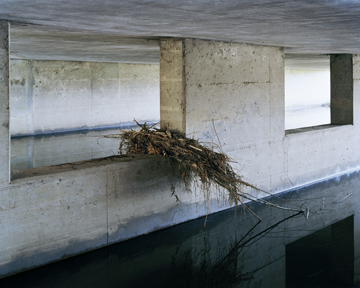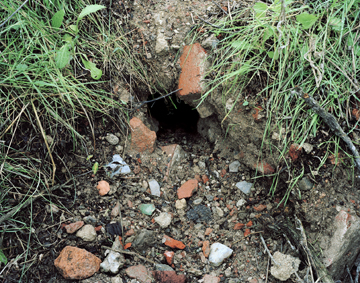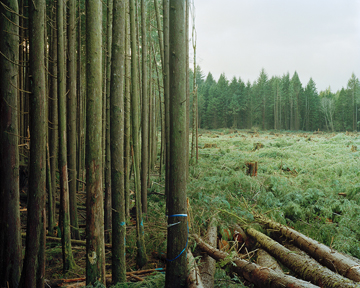
Eirik Johnson, Untitled 2003 (#2 debris under the bridge), 2003, from the series Borderlands
We invited photographer Eirik Johnson to write about his ongoing exploration of humankind’s environmental impact. Works in his most recent series, Sawdust Mountain, are on view at the Henry Art Gallery through January 31, 2009. — Ed.
I have an insatiable curiosity. I think that’s why I became an artist and in particular, a photographer. As a young boy, I would explore the urban woods near my family house in Seattle, WA. The tangle of fir trees, bushes, and ferns were a testing ground for imaginary expeditions and fort building techniques. I liked the messiness of nature. I dug up earthworms, watched crows flock overhead, picked blackberries, felt the rain fall from the cedar branches above. Looking back now, these early childhood experiences in the landscape have become a constant source of inspiration for my creative work.
My series Borderlands sprang from a desire to look again at these urban wilds, where natural and manmade changes to the landscape conflate and create something new. These are makeshift spaces, where flooded rivers deposited debris along freeway columns, where sweaters are tied together to mark out someone’s encampment, where a lightning sparked fire chars the view behind an office park.

Eirik Johnson, Berkeley, CA 01, 2006, from the series Animal Holes
There is something sad about these landscapes. They are, after all, located in the neglected empty space which exists between public and private land. Yet, these spaces also offer a constant reminder of the resilience of nature. This theme of ecology adapting to change was what inspired my next project, Animal Holes. It was on one of my urban expeditions along an old landfill in California that I came upon a warren of feral jack rabbit holes. What caught my eye was that in burrowing their holes, the rabbits had also unearthed piles of jewel-like treasures from the landfill below. Bits of rusted metal, rubber hose, and iridescent glass sat like offerings in front of each black hole. The animal holes embodied the idea of the makeshift landscape on a micro-scale, a sort of intimate epilogue to the Borderlands project.
Over the last four years, I have turned my attention back to the Northwest to make work specifically addressing the complicated relationship between the region’s landscape, industries that rely upon natural resources, and the communities they support. As with my earlier projects, this work has its origins in childhood memories. When I was young, my family would hunt for mushrooms in the forests of the Cascade and Olympic Mountains. Some days we would spend afternoons along the shallows of a river watching salmon fight their way to spawning grounds upstream. These were the icons of the region: forest and salmon, pillars of Northwest identity.

Eirik Johnson, Freshly Felled Trees, Nemah, Washington, 2007, from the series Sawdust Mountain
In returning to the Northwest to work on my most recent book project Sawdust Mountain, I found a wet and weathered region imbued with much history but an uncertain future. The forests of the coastal mountains are a patchwork of logged clearings, young third and fourth growth timber and occasional pockets of old growth. Mountains, covered with Douglas fir seedlings barely a foot tall, appear physically shrinking in size. Yet like the old growth forests, the industries themselves and the towns they helped build are also a shadow of their former size and importance. Mills have closed, unemployment runs high, and folks scratch out a living selling sweaters out of a former Masonic Lodge or doing odd jobs for the local tavern.
I think that all three of these projects, Borderlands, Animal Holes, and Sawdust Mountain are a reaction to my relationship with a changing landscape. The work is colored by both childhood memory and a desire to address man’s impact on the landscape. In the end, all of us, artists included, are stakeholders when it comes to the environmental legacy we wish to leave for future generations.
Eirik Johnson is a photographer currently based in Boston, MA. He is Assistant Professor of Photography at Massachusetts College of Art.


